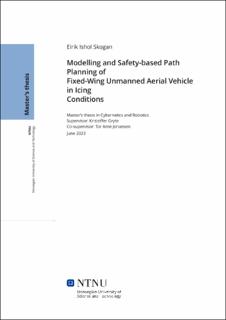| dc.contributor.advisor | Gryte, Kristoffer | |
| dc.contributor.advisor | Johansen, Tor Arne | |
| dc.contributor.author | Skogan, Eirik Ishol | |
| dc.date.accessioned | 2023-09-30T17:21:38Z | |
| dc.date.available | 2023-09-30T17:21:38Z | |
| dc.date.issued | 2023 | |
| dc.identifier | no.ntnu:inspera:140443607:34883894 | |
| dc.identifier.uri | https://hdl.handle.net/11250/3093323 | |
| dc.description.abstract | Etter hvert som ubemannede luftfartøyer (UAV) fortsetter å øke i popularitet,
utvides bruksområdet deres. Utfordringer knyttet til operasjoner under harde vær-
forhold, spesielt ising, dukker opp sammen med nye bruksområder og strengere
krav til pålitelighet. Denne avhandlingen konfronterer disse utfordringene ved å
utvikle en omfattende matematisk modell av en spesifikk fastvinget UAV, kalt Falk,
som inkluderer påvirkningen av ising på aerodynamikk og vektfordeling.
Falk-modellen er simulert i forskjellige isingsscenarier: ingen is, iset vinge, iset
hale og fullt iset (både vinge og hale er iset) under ulike isingsforhold. Isings-
forholdene bestemmes først og fremst av temperatur, absolutt luftfuktighet (LWC)
og vanndråpestørrelse (MVD). Ulike værforhold bidrar til akkumulering av for-
skjellige isformasjoner. Fokuset i denne studien er å forstå hvordan ulike isdan-
nelser påvirker Falks flyegenskaper og stabilitet. Fra stamp og rull sprangresponser
undersøkes modellens begrensninger på grunn av isakkumulering, spesielt kon-
trollflatemetning. Studien finner at i en stampmanøver påvirker distinkte isdan-
nelser flyegenskapene betydelig forskjellig. I noen forhold kan is kun på halen
redusere stabilitetsmarginene mest, mens i andre er is på vingen og halen mest
alvorlig. Viktigst av alt, under svært alvorlige isforhold vil høyderoret gå i metning.
Spranget i rull gjøres i en koordinert sving for å opprettholde høyden. I en slik
sving er en isete hale mest innflytelsesrik på flyegenskapene, og kan føre til plut-
selig metning av balanseroret og dermed ustabiliteter. Interessant nok fører is på
bare vingen til mindre reduksjon av styrerorenes metningsmarginer. En iset vinge
øker imidlertid luftmotstanden og dermed energiforbruket betydelig. Stamp og
rull-manøvrene under isingsforhold understreker kompleksiteten til isdannelser
og flydynamikk.
Modellen blir deretter integrert i en baneplanlegger som bruker en Rapidly-exploring
Random Tree-algoritme, nærmere bestemt RRT* algoritmen. Planleggeren tar sikte
på å finne en nesten optimal, energieffektiv bane som begrenser eksponeringen
for isforhold og unngår farer forårsaket av ugjestmildt vær. Den tar også hen-
syn til vind, som påvirker flyegenskapene betydelig. Ytterligere funksjoner som
unngåelse av hindringer og terrengfølging er integrert i planleggeren. Resultatet
fra baneplanleggeren er den mest energieffektive banen som er trygg å fly uten
bruk av et avisingssystem (IPS). Store områder med isende forhold kan begrense
baneplanleggeren på den måten at den ikke kan finne en gjennomførbar bane.
Videre arbeid med å implementere en avisingsmodell vil utvide bruksområdet til
baneplanleggeren.
Baneplanleggeren er testet i både kunstige og virkelige miljøer, og den demon-
strerer sin evne til å unngå isingsfarer og finne en sikker bane. Mens planleggeren
fortsatt er i en konseptuell fase, viser den et betydelig potensial for videreutvikling
og anvendelser. Denne avhandlingen gir verdifull innsikt i isingsproblematikken
hos UAVer, og fremmer sikkerhet og effektivitet i et voksende bruksområde. | |
| dc.description.abstract | As Unmanned Aerial Vehicles (UAVs) continue to rise in popularity, their range
of applications expands. Challenges associated with operating in harsh weather
conditions, particularly icing, arise along with new applications and stricter reliab-
ility demands. This thesis confronts this concern by developing a comprehensive
mathematical model of a specific fixed-wing UAV named Falk, which includes the
effects of icing on aerodynamics and weight distribution.
The Falk model is simulated in different icing scenarios: no ice, iced wing, iced
tail, and fully iced (both wing and tail iced) in various icing conditions. The icing
conditions are primarily determined by temperature, liquid water content (LWC)
in the air, and water droplet size (MVD). Various weather conditions contribute to
the accretion of different ice formations. This study focuses on understanding how
different ice formations affect the UAV’s flight performance and stability. From
pitch and roll step responses, the model’s limitations due to ice accumulation are
investigated, particularly control surface saturation. The study finds that in a pitch
maneuver, distinct ice formations affect performance significantly differently. In
some conditions, ice only on the tail reduces the stability margins the most, while
in others, ice on the wing and tail is the most serious. Most importantly, in very
severe icing conditions, the elevator will go into saturation.
The rolling step is done in a steady coordinated turn to maintain altitude. In such
turn is an iced tail most influential and can lead to sudden aileron saturation and
instabilities. Interestingly, ice on just the wing leads to less reduction of control
surface saturation margins. However, an iced wing significantly increases drag and
propulsion power. The pitch and roll maneuvers in icing conditions underscore the
complexity of ice formations and flight dynamics.
The model is then integrated into a path planner that utilizes a Rapidly-exploring
Random Tree algorithm, specifically the RRT* algorithm. The planner aims to find
a near-optimal, energy-effective path that limits exposure to icing conditions and
avoids any icing hazards. It also considers winds, which significantly affect flight
performance. Additional capabilities like obstacle avoidance and terrain following
are incorporated into the planner. The resulting path is the most cost-effective that
is safe to fly without the use of an ice protection system (IPS). The path planner
is limited to the fact that there must be a feasible path that does not violate any
constraints. Further work on implementing IPS will expand the versatility of the
path planner.
The path planner is tested in both artificial and real-world environments, demon-
strating its ability to avoid icing hazards and find a safe path. While the planner
is still in a conceptual phase, it shows considerable potential for further devel-
opment and application. This research provides valuable insights into addressing
icing problems in UAV operation, promoting safety and efficiency in a growing
field. | |
| dc.language | eng | |
| dc.publisher | NTNU | |
| dc.title | Modelling and Safety-based Path Planning of Fixed-Wing Unmanned Aerial Vehicle in Icing Conditions | |
| dc.type | Master thesis | |
